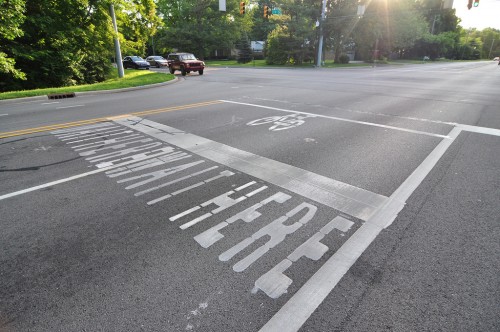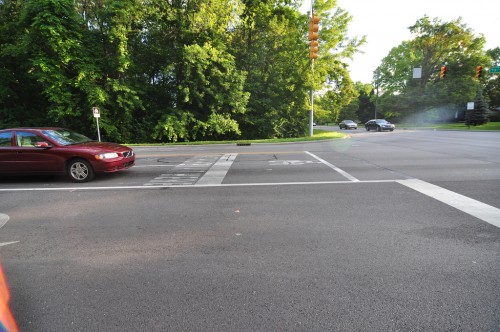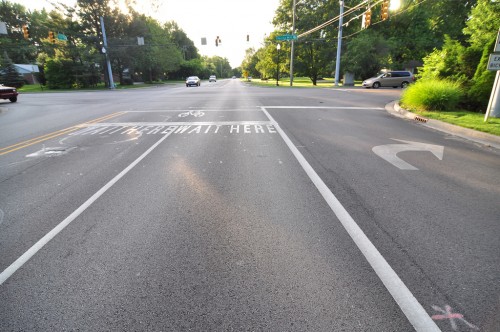
North Side drivers who use 73rd Street have undoubtedly seen these new pavement markings and wondered, “What are they and what am I suppose to do?” These new striping patterns are Indianapolis’ first Bike Boxes. What are bike boxes? According to the DPW’s Bike Boxes website (they actually created a dedicated site to talk about these),
“…by definition, a designated area at the head of a traffic lane at a signalized intersection that provides bicyclist with a safe and visible way to get turning bicyclist ahead of queuing traffic during the red signal phase. Bike boxes serve as an advanced stop bar and do not affect moving traffic.”
So, now that we know what they are and what they do, what can cyclists and motorists expect out there in the real world? First, the familiar sight of a bicycle should clue drivers off that the new striping is to aid cyclists. What they won’t be familiar with is the additional space at the head of the line where the bike is located.

The pictures I snapped, at the intersection of 73rd & Spring Mill Road, indicate just how the boxes work. The existing bike lane feeds into the box at the head of traffic, allowing cyclists to bypass stopped auto traffic at the signal and obtain a safe area to turn left or right onto Spring Mill. Spring Mill Road has also been outfitted with a number of sharrows (sorry, no bike lanes), so from a network perspective, the bike boxes serve a real function in giving cyclists some visibility on what is, for lack of better description, a high speed suburban style through-way.

Indeed, as I was taking these pictures during morning rush hour, cars zoomed by at uncomfortable speeds by pedestrian standards. This is compounded by the lack of sidewalks. I have to admit, when I first read about the locations I wondered, “Why here?” and after visiting to take the photos I can vouch, the need for safe facilities for cyclists seems real here. I only stopped at 73rd & Spring Mill for these photos, but similar layouts are also employed at 71st & Cross Key Drive and 71st & Lakeview, on the west side.
Will these new safety improvements boost cycling share in these areas? Time will tell. As I pointed out in yesterday’s post about the coming 71st Street Bike Ways, this corridor is highly suburban so there is a clear need for making the roads safer for cyclists.
??? Curmudgeon alert. I certainly agree that the area around 73rd and Spring Mill needs improvement for bike safety. The “bike box” seems fraught with danger, however. I visited the DPW site, watched the video, and “sorta” get it. What I don’t understand is how 1 million people in the Indianapolis area will understand the purpose of the confusing graphic design on a street. Most people will not watch the DPW’s bit-too-funny video. Frankly, if there is traffic, I will continue stay on the far right, wait for the traffic to go by, and then turn left. I’ve been hit before and don’t trust cars. I certainly won’t trust them not to get angry with me as I “cut” in front of them at a stoplight — especially if one of them is also turning left. Bikes move slower than cars. Motorists behind are not pleased being “stuck” behind us.
I live in Portland and it took a while for drivers to catch on when they were first introduced here. Most drivers are in the habit now of stopping behind the line. Its takes a while and there will always be someone though, usually not from the area, who doesn’t understand it. Thoses are the ones you still have to watch for after the regular drivers and cyclists get in the habit of using the system correctly.
Its exciting to see all the new bike infrastructure popping up in Indy. I’m bringing my road bike when I visit in August so I can take a tour of it!
There is always a transition period into something new. That comes with the nature of being human. I certainly understand that you’re not going to take the risk, and with the way the box was painted it doesn’t seem to be completely clear.
I don’t know why they didn’t designate this box with a different color to show that it is an unique area. Painting another thick white outline really doesn’t delineate between the two. Would have be good to at the very least apply the green paint that they’ve done with the bike lanes on Allisonville. It would bring a little more attention to the intersection.
Portland saw the number of right hook accidents double with the bike boxes. There are many problems with them.
This from the same article Mr. Ogden sited: “During a four-year period, the number of crashes involving a motor vehicle turning right into bicycle riders doubled from 16 to 32.
At the same time, studies show about 98 percent of vehicles properly yield to bicyclists at the boxes.Burchfield wrote that he’s confident that the boxes will ultimately prevent conflicts as the volume of bicycle commuters passing through the boxes increases.”
inherent problem here is that drivers don’t stop at the line at most any intersection, bike box or not. They’ll simply pull into the bike box and wait for the light, or inch into it while waiting.
Oops, after replying to the thread, I see you made my point already.
I pedaled through that intersection on Friday. By the time I could see there was a bike box in place, I had already made my way to the left turn lane. Made me wonder if we aren’t missing some signage for both cyclists and motorists.
Glad you pointed this out, Curt. Kind of functions vaguely like the staggered stop bars for cars in adjacent lanes, protecting the ones who want to turn so that vehicles in neighboring lanes don’t block their line of sight.
Agree with previous posters…I’m curious as to why the boxes were not painted green. That’s what I’ve seen in other cities.
In a perfect world, we would have these instead…
http://wiki.coe.neu.edu/groups/nl2011transpo/wiki/ba51e/
Yeah, I’m dreaming, but seriously, why not skip the cheap half-measures, learn from those who have gone before us, and do it right? Forget painted bike lanes…lets drop some coin, build separated cycle tracks instead, and put in bike infrastructure that moms, kids, and grandmas would feel safe on.
(steps off soapbox)
The trouble with this is the DPW thinks bicycles will use the same roads cars do. You go where the cars don’t go. Avoid this intersection altogether and take 77th St. to Holiday Dr. W. then south. Actually Meridian Hills Blvd. is a crappy road too so best take 75th st. east then south on Penn.
Paint the boxes green and a lot of potential problems would be solved.
Yeah, where’s the green paint/thermoplastic? I thought that was the standard design for bike boxes.
Weak at best. Personally would not use that box..scary!
The first test will be whether drivers stop where they’re supposed to. An awful lot don’t do that today, opting to park their front wheels out over the wide white strip and creep, creep, creep as if that’s going to speed the light changing from red to green.
I have it on good authority that green thermostriping will be coming to these boxes in a couple weeks.
🙂
Its green now. While I have yet to see a bike use it, I have not seen any cars totally ignore it. The giant “Wait Here” is hard to miss. Also they have not turned on the left turn arrow yet. this is critical to the left turn flow
David Hembrow – http://www.aviewfromthecyclepath.com :
“I don’t much like advanced stop lines (aka “bike boxes”). Cyclists filtering through traffic to reach a bike box can find themselves an unpleasant situation on the wrong side of turning vehicles when the lights change. They can be subject to intimidation by drivers behind them, and upon reaching the bike box a cyclist can find that it is already full of cars or motorbikes. On a small road with few motor vehicles, they can just about work. On a multi-lane road like this, there are far too many points of conflict where cyclists and drivers will have to cross each others’ paths and they should not be considered. It’s a world away from sustainable safety:”
“Bike boxes are still sometimes seen as aspirational in other parts of the world, but far from being an ideal to aim for, they’re actually one of the least effective measures that can be taken for cyclists. Bike boxes are increasingly uncommon in the Netherlands.”